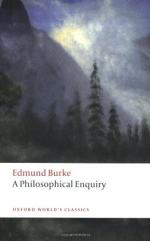
|
| Name: _________________________ | Period: ___________________ |
This quiz consists of 5 multiple choice and 5 short answer questions through Introduction On Taste Part II.
Multiple Choice Questions
1. Which two ideas does Burke often find confused with one another?
(a) Picturesque and picaresque.
(b) Liberty and patriotism.
(c) Sublime and beauty.
(d) Fear and terror.
2. What does Burke hope will be the result of his "A Philosophical Enquiry Into the Origin of Our Ideas of the Sublime and Beautiful"?
(a) Readers will apply principles of taste and passion to the otherwise severe sciences.
(b) Readers will leave the sciences behind in favor of imagination and passion.
(c) Readers will learn to control their passions when in specific social settings.
(d) Readers will be well-versed in the scientific method.
3. What problem does Burke find with merely defining a term like "taste?"
(a) People may disagree with and contest his definition.
(b) The process of defining the term may go on forever, and become overwhelming.
(c) Taste is only an idea, not a reality, so it cannot be defined or described.
(d) There is a danger of confining and limiting the term to our present understanding.
4. What is the same in all humans, according to Burke?
(a) The general intelligence quotient.
(b) The curiosity and wonder for nature.
(c) The capacity for feeling.
(d) The standards of reason and taste.
5. What is Burke's general plan of action for this book?
(a) It will refute all other theories of the sublime.
(b) It will focus only on human society.
(c) It will be a methodical study.
(d) It will posit wild, untested new ideas.
Short Answer Questions
1. How do all emotions and passions affect the human mind?
2. What example does Burke use to demonstrate that differing tastes stem from the same basic root?
3. What examples does Burke use to prove that people agree upon sensory observations?
4. Why, as Burke argues, are humans "more inclined to belief than to incredulity?"
5. What natural powers in man does Burke say relate to external objects?
|
This section contains 445 words (approx. 2 pages at 300 words per page) |

|




